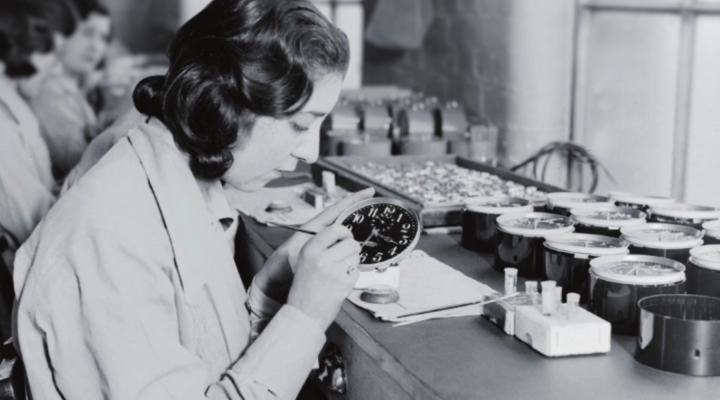
It’s against the law for employers to make you sick. Thank the "Radium Girls" for that
It’s against the law for employers to make you sick. Thank the "Radium Girls" for that

They called it “lip pointing.” It was how the dial painters at United States Radium Corp. kept their paintbrushes from fraying between strokes. The employees, mostly young women, would stick the end of their brush between their lips to make a fine tip before dipping it into a luminous radium powder paint. The paint, which glowed in the dark, was applied to instruments, dials and watch displays that were shipped off to pilots fighting in World War I. Point, dip, paint — and repeat. It was meticulous work, and although they did not know it at the time, it was killing them.
U.S. Radium Corp. opened their factory in Orange, New Jersey, in 1917. Radium, a newly discovered element, was all the rage — used for making things glow in the dark and sold in tiny amounts to ward off illness. For the working-class women of northern New Jersey, landing a job as a dial painter at U.S. Radium Corp., a business at the center of the radium boom, was an achievement.
“Dial painters earned more than three times the average factory floor worker,” said Kate Moore, author of the book, “The Radium Girls: The Dark Story of America’s Shining Women.” “It wasn’t just the money, the camaraderie was fabulous, the women talked of the way they would share gossip, snacks, sandwiches across the dusty tables.”
Radium dust, considered safe at the time, covered the factory floors and work tables, as well as the women’s bodies. “They were nicknamed ‘the ghost girls’ because as they walked home at night, they would glow ethereally,” said Moore, “they would literally be covered in it.”
It wasn’t until about five years later — after many of the women had moved on to new jobs, new cities or to have families — that they started getting sick. Their bones disintegrated, large tumors appeared on different parts of their bodies and pieces of their jaws and teeth fell out. Then they began to die. The sickness was dramatic, but also mysterious. Radium poisoning had never been observed or diagnosed before. Manufacturers, like U.S. Radium Corp., had a vested interest in radium’s perceived safety.
“When the women died, some of them were buried on death certificates mistakenly for syphilis — that was seized upon by these companies,” Moore said. “[The women] are trying to speak out, and of course the radium firms not wanting that lucrative industry to be affected in the slightest, they’re silencing the women with everything they’ve got.”
At the time, there were legal limits on which diseases companies were liable for. Even if the women could prove they were suffering as a result of their work as dial painters, radium poisoning was not on the short list of illnesses businesses had to worry about. Also, a two-year statue of limitations kept workers from suing companies for a condition like theirs that did not present quickly.
The women, even as they were dying in hospital beds or disabled at home, fought back along with the New Jersey Consumers League, their families and a few brave lawyers. Meanwhile, dial painters working for other companies in other states looked on.
“They were going to die, there was no hope for them,” said Moore, except to change the law. Through a series of legal cases and media attention, the law was changed — as well as the way we think about worker safety and employee protections. Decades later, the Occupational Safety and Health Administration was created.
“It was one of the very first cases in which an employer was held accountable for the health of its employees, and so it lays the groundwork for organizations like OSHA that will eventually protect many millions of other workers,” Moore said, “and I think that’s quite a legacy to leave.”
| What do you do when your company has no HR department? |
| Workplace injuries going unreported due to cost |
| How women pay an economic price after sexual harassment |
There’s a lot happening in the world. Through it all, Marketplace is here for you.
You rely on Marketplace to break down the world’s events and tell you how it affects you in a fact-based, approachable way. We rely on your financial support to keep making that possible.
Your donation today powers the independent journalism that you rely on. For just $5/month, you can help sustain Marketplace so we can keep reporting on the things that matter to you.


















